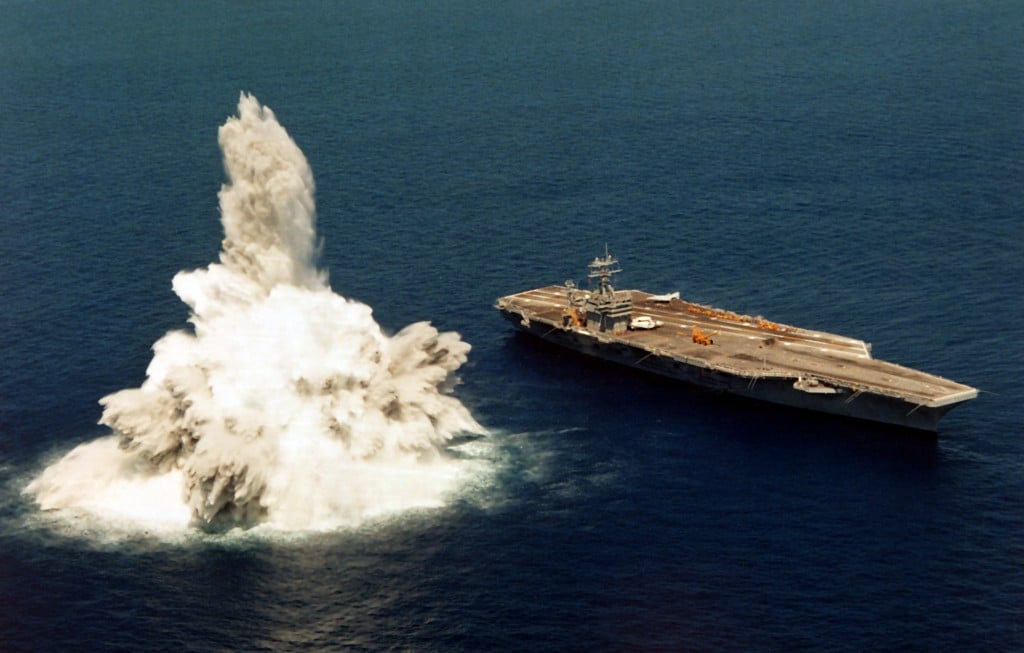
A US Navy carrier, the USS Roosevelt, undergoing “full-ship shock trials” using live explosives.
WASHINGTON: China has an arsenal of long-range ship-killing missiles, based on land but able to hit US warships hundreds of miles offshore. Now the chairman of the House seapower subcommittee suggests we give them a taste of their own “anti-access/area denial” medicine. Why shouldn’t the US Army develop its own land-based anti-ship missile force?
Rep. Randy Forbes has carefully timed his letter to the Army Chief of Staff, Gen. Ray Odierno, sending it on the eve of the service’s largest annual gathering, the massiveAssociation of the US Army conference here in Washington. Nor does Forbes pull his geopolitical punches: He explicitly advocates “ground-based anti-ship missiles… specifically for deployment in the Western Pacific [to] offset current strategic advantages by the People’s Republic of China.”
“The Army’s existing expertise in missile defense, rocket and missile systems for offensive precision fires, and partner-capacity building make it a natural choice to spearhead… an integrated web of A2/AD systems among allies [that] would greatly increase the costs of any hostile action in the region,” Forbes continues.
While the Air Force and Navy-led Air-Sea Battle concept focuses on breaking into an enemy anti-access/area denial system, certain thinktanks have advocated the US and its allies setting up our own A2/AD to keep the Chinese out. (Forbes cites a 2013 RAND report, but the Center for Strategic and Budgetary Assessments is also big on the idea). After all, it’s China that seeks to change the status quo and would be tempted to seize disputed islands, be they the uninhabited Senkakus off Japan or the entire country of Taiwan. China fought a war with Vietnam in 1974 to take the Paracel Islands and has established outposts since in other disputed regions of the South China Sea — which, unlike Japan and Taiwan, is mostly outside the range of missiles and aircraft based in mainland China.
In many scenarios, therefore, the Chinese would have to come to us, not vice versa. So why not invest in defenses that would make them work for it?
The hang-up is international law and nuclear escalation. The US and the Soviet Union signed a treaty in 1987 on Intermediate-range Nuclear Forces (INF) in which they promised to give up land-based ballistic and cruise missiles with ranges between 500 and 5,000 kilometers (about 300-3,000 miles). The idea was to stabilize the Cold War by removing an entire class of nuclear weapon that the Soviets found particularly threatening: The US had been deploying Army Pershing II missiles that could hit Russia from European bases, while its Soviet equivalents could not reach the US. But the INF treaty was written to ban missiles with conventional warheads as well as nuclear ones, since it’s impossible for the target to tell which is which until it explodes.
Russia has violated the INF treaty by testing a prohibited missile — at least according to the Obama administration – so arguably it’s a dead letter. But there’s still the possibility of a targeted country confusing a incoming conventional missile with a nuclear first strike. The potentially apocalyptic repercussions are why the US backed off the Prompt Global Strike program to put conventional warheads on ICBMs. The Air Force does retain a small force of nuclear Air-Launched Cruise Missiles (ALCMs), but the Navy has retired all ship-launched nukes.
So developing land-based anti-ship missiles would be a big and potentially destabilizing step. But as Gen. Odierno told Forbes at a hearing earlier this year, the idea “is worth taking a look at.” And there is a precedent for the Army being in the ship-killing business: For over a century, from the Battle of Fort McHenry in 1814 to the eve of World War II, one of the service’s most prestigious branches was the Coastal Artillery.
No comments:
Post a Comment